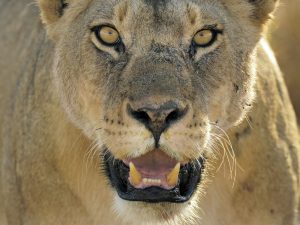The Serengeti National Park is not only the most famous national park but also the oldest national park in Tanzania. The area was declared a protected area since the year 1921, and later as a national park in the year 1951 being the first gazetted national park in the Country.
Serengeti national park itself covers an area of 14,763 Km square but it is part of the larger Serengeti-Masai Mara Ecosystem that covers more than 30. 000 Km square. The Ecosystem includes the Ngorongoro Conservation Area, Serengeti National Park, Ikorongo, Maswa and Grumeti Game Reserves, Masai Mara game Reserve (in Kenya), and some other game controlled areas around the area like Loliondo between Lake Natron and Serengeti.
Serengeti National Park – home to Great Wildebeests Migration in Tanzania

Probably what makes Serengeti National Park the most famous is the annual Wildebeests migration also known as ‘The Great Migration’ that involves more than 1.5 Million herds of wildebeests accompanied by hundreds of thousands of zebras and gazelles. This annual natural phenomenon, also referred as the 7 wonder of the world sees the animals cover thousands of kilometers every year crossing the border from Tanzania to Kenya and back, in search of Water and green pastures.
The vastness of the plains in Serengeti National Park gave the area the name. The name Serengeti was derived from a Masai word ‘Siringit’ that literally means; endless plains.
An African safari to Tanzania with, Serengeti National Park included is an ultimate safari. The national park has a very high concentration of resident animals that includes among many others; the lions, elephants, leopards, cheetahs, warthogs, giraffes, serval cats, gazelles, topis, and many other species. The list is endless… For the bird watchers, this national park will amaze you with the number of species one can spot in a single day. The bird species the Serengeti National Park includes; The larger species; like Ostriches, Secretary birds, Kori bastards, Hammerkops, and many smaller species like the weavers, starlings, sun birds, doves, pigeons, honey guides, and many other species.
Serengeti is quite a long drive from and to Arusha, the safari base town, and is best reached after a visit to other destinations; Lake Manyara National Park and the Ngorongoro Crater. However flights to and from Serengeti National Park are available from Arusha, Dar es Salaam and Zanzibar.
In your next safari to Tanzania, please kindly let us know if you wish to visit the Serengeti and we shall include it in your safari itinerary.
Serengeti National Park where to stay?
Some of the lodges and tented camps around Lake Manyara includes:
Kirawira Tented Camp
Kusini Camp
Dunia Camp
Mbalageti River Lodge
We can always advise you on the best accommodation to stay in depending on when you want to visit for your Tanzania Serengeti safari.
You may be interested in coming to Tanzania and visiting the Serengeti? Please have a look at our 4 day Tanzania Serengeti safari with prices.
Where is the location of Serengeti National Park?
The Serengeti is one of largest parks in Tanzania and it is located in the North East of Tanzania. The park is borders Masai Mara Game Reserve in Kenya from the north. Serengeti is a major component to most Northern Tanzania safari programs and you can access the park by road or by flight. Serengeti National Park borders Ngorongoro Crater (Ngorongoro Conservation Area) on the south which makes it easy to combine the two major wildlife areas in the Northern Tanzania safari circuit but you may also consider including Lake Manyara and Tarangire national parks if you have enough time.
By flight you can access Serengeti from Arusha town, Dar es Salaam, Zanzibar Island or even from other parks by flying from the small airstrips that are located in the several parks in Northern and Southern Tanzania safari circuit. The flight to or out of the Serengeti is a good think to consider if you want to have a relaxed tour to Serengeti and especially if you are not visiting other parks that usually helps in breaking down the driving distances or if you are coming from Dar es Salaam or Zanzibar. If you are also traveling with the elderly folk or young kids, the fly in safari to Serengeti National park would be the best option.
The distance from Arusha to Serengeti is around 350 Kilometers but due to the conditions of the roads, the driving time is around 6 – 7 hours depending on the stops that you will make on the way. To access Serengeti National Park by driving, you will have to access the Ngorongoro Crater and traverse the Conservation area at Ngorongoro. You will therefore need to pay the transit park entry fees for Ngorongoro Crater for both the passengers and the car.
Please note – that you can never drive by road from Dar es Salaam to Serengeti National Park. The best major airport to fly in if you need to visit Serengeti; is Kilimanjaro International Airport. You may need to spend your first night at Arusha town before driving or flying into Serengeti depending on the time that you arrive at Kilimanjaro International Airport (JRO).
Wildlife in Serengeti National Park
Serengeti National Park is an integral part of a Tanzanian safari tour because of the large variety of wildlife species that can be found in this park. The Wildebeests Migration is definitely the park’s main attraction.
The Great Migration as it is popularly referred to, the wildebeests migration is a movement of around 2 million wildebeests accompanied by around 350,00 Thompson gazelles and upto 200, 000 zebras from Ndutu in Southern Serengeti towards the North Serengeti through the Western Corridor and ultimately crossing the Mara River to enter Masai Mara Game reserve in Kenya, in what has now been recognized as the biggest wildlife spectacle on planet earth.
The Serengeti is also home to unbelievably large number of predator species, with the park having numbers of up to 4000 lions and very high numbers of leopards, cheetahs and hyenas. The park is also home to large and small game alike including; elephants, giraffes, genets, primate species like baboons, vervet & colobus monkeys, zebras, topis, aardvarks, elands, buffaloes, jackals, Nile crocodiles, warthogs and many bird species (around 500 species recorded in Serengeti). Read more here to learn on 20 animal species that you can see in the Serengeti National Park.
Scenery in Serengeti National Park
The word Serengeti is derived from a Masai word as explained; the word meaning ‘endless plains or literarily – plains without end’. True to its name, the Serengeti National Park is known for vast savannah grasslands in the south East, while the Northern Serengeti in areas like Bologonja, and Lobo, it is hilly and rocky.
Western Serengeti consists of valleys, forests and rivers like Grumeti and Mbalageti. Many areas of the Serengeti are dotted by Kopjes (rocky granite outcrops) that raise up above the plains. These make good watch towers for predators especially lions which like to relax on top of the Kopjes patiently watching the plains below in order to spot the best prey targets.
Best time when to go to the Serengeti National Park
Serengeti National Park is generally an all-year round destination! The park can be accessed any time of the year. Apart from accessibility throughout the year, the park is the arguably the best park in Africa because of the incredible abundance of wildlife and birdlife. Focusing only on the Great Wildebeests Migration would therefore be a great injustice to this glorious park.
The best time to visit Serengeti for wildebeests migration if you are interested in the river crossing in Northern parts of the park is between July and October. In case you are interested in the calving and breeding season then visiting during the months of December to March would be best. The rest of the time is Ok for seeing the wildebeests in their thousands in the central and western Serengeti as well as the general wildlife which is available in the park (in abundance) throughout the year.
Ordinarily weather conditions in the Serengeti are rarely harsh during the months of June to October; the dry season. The temperatures at that time are nice and warm.
Serengeti Migration | When is the Great Migration in the Serengeti?
Contrary to what many people think; the Wildebeests Migration herds can be seen in the Serengeti almost throughout the year. The migration cycle starts from Ndutu Plains in Southern Serengeti in December through March. April to June they cross the Central Serengeti, The Western Corridor and through North Eastern sides of Ikoma area towards the Kogatende areas in Northern Serengeti.
The peak of the migration of the wildebeests from Serengeti to Masai Mara in Kenya is Mid-July to September when they are at Northern Serengeti crossing to Masai Mara. From Mid October the herds are back again crossing from Masai Mara in Kenya to Serengeti in Tanzania where they stay for the rest of the year again.
This proves to you that you can do a Wildebeests Migration safari in Serengeti at any time of the year. After all the river crossing is only for the lucky few, because no one knows when they will do the actual river crossing at Mara River.
It is always to combine Masai Mara in Kenya and Serengeti in Tanzania in one safari itineraries like what we have in our various Kenya Tanzania safari programs and sample tours.
The Climate of Serengeti National Park
Serengeti’s climate is normally very moderate and nice. Serengeti’s weather never gets too hot because the wind constantly blows all the time. The nights are normally cool which explains why most tented camps do not offer air conditioning or fans in the tented rooms. Early mornings can be very cold sometimes so it is important to remember caring warm clothing. Not a winter jacket though; only a fleece or normal jacket would suffice.
Serengeti’s Dry season just like most parts of East Africa starts in June and ends in October. We have two two Wet seasons in the Serengeti just like in most parts of East Africa. The ‘short rains’ falls between November to December and this time mostly we experience showers in the evenings but the days are clear and sunny days. The ‘long rains’ season on the other hand runs between the months or March to May. Even in Wet season it rarely rains in the Serengeti the whole day, most rainfall is experienced in the afternoon and in the evenings. See our sample; combined Kenya & Tanzania safari for 10 days.
During the Dry seasons, temperatures in the afternoons are usually approximately 25°C/77°F with clear skies most of the days. The temperatures in the night can fall to 14°C. Mornings are usually very cold in the Serengeti throughout the year.
During the Wet season afternoon, just like the dry season temperatures are usually around 26°C ( approx. 79° F) while the night temperatures can fall up to around 15°C (approx. 59°F).
If you are ready for a Tanzania safari of your lifetime, please get in touch with our experts for free advice on how you can tour Tanzania and have your itinerary include Serengeti National Park!
